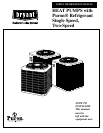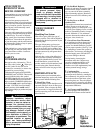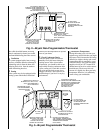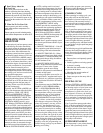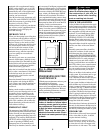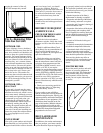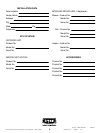
4
Don’t Worry About Ice
On Your Unit
Ice or frost will tend to form on the
outdoor coil during the winter heating
operation. Your heat pump is designed to
automatically melt the ice. When in this
defrost cycle, it is normal for steam or fog
to rise from the outdoor unit. Do not be
alarmed!
When Not To Use Your Unit
Do not operate your unit in cooling
mode when outdoor temperatures are
below 55°F.
Do not operate your unit in heating mode
when outdoor temperatures are above 66°F.
OPERATING YOUR
HEAT PUMP
The operation of your heat pump system
is controlled by the indoor thermostat.
You simply adjust the thermostat and it
maintains the indoor temperature at the
level you select. Most thermostats for
heat pump systems have three controls: a
temperature control selector, a FAN con-
trol, and a SYSTEM or MODE control.
The temperature control selector is a dial,
lever, or set of buttons that allows you to
establish the degree of temperature that
you wish to maintain for your personal
comfort. Some thermostats possess
two temperature control selectors: one
for setting the temperature desired during
the cooling cycle, and one to set the heat-
ing operation temperature.
The FAN control offers two options for
controlling the indoor blower: AUTO and
ON. When set to AUTO, the blower runs
only during the time the heat pump is
operating. When set to ON, the blower
will run continuously.
Typically, the SYSTEM or MODE con-
trol on your thermostat offers the follow-
ing selections: COOL, OFF, HEAT,
AUTO, and EMERGENCY HEAT.
Some thermostats may have a separate
switch for EMERGENCY HEAT. The
heat pump will not operate when the
SYSTEM or MODE control is set to
OFF. With the SYSTEM or MODE con-
trol set to COOL, your heat pump will
operate in cooling mode when the indoor
temperature rises above the level that you
wish to maintain. With the SYSTEM or
MODE control set to HEAT, your heat
pump will provide warmth whenever the
indoor temperature falls below the level
that you have selected.
The AUTO selection found on some ther-
mostats provides for automatic change-
over between cooling and heating cycles.
With the SYSTEM or MODE control set
•
•
to AUTO, cooling mode is activated
when the indoor temperature rises above
the thermostat cooling temperature set-
ting, or heating mode is activated when
the indoor temperature drops below the
thermostat setting for the heating cycle.
Depending on your typical winter heating
needs, your home comfort system may
include a supplementary heating source.
The EMERGENCY HEAT setting
(EHEAT) provides for convenient selec-
tion between the two heating appliances.
Your heat pump will operate when the
SYSTEM or MODE control is set to
HEAT. With the SYSTEM or MODE
control set to EHEAT, the heat pump will
turn off and the supplementary heat
source will be activated.
NOTE:
Your 2-speed heat pump system
has several special features built in to pro-
tect the unit.
• 5-MINUTE TIME DELAY—Unit will
delay operation upon initial start-up or
short-cycling of the indoor thermostat.
• 1-MINUTE TIME DELAY—When
changing speeds from low to high, or high
to low, there is a 1 minute time delay. Dur-
ing the speed change delay, the outdoor
fan will continue to run.
• 1-MINUTE HIGH-SPEED MINI-
MUM—If the unit has not operated with-
in the past 12 hours or has a power
interruption, upon the next cooling
demand, it will operate for a minimum of
1 minute on high speed.
In certain geographic areas and in cer-
tain applications, supplemental heat is
not required. Any questions regarding
your application should be directed to
your dealer.
Your thermostat may be PROGRAM-
MABLE or NON-PROGRAMMA-
BLE. A NON-PROGRAMMABLE
thermostat (See Fig. 2.) does not allow
the temperature settings to be varied
throughout the day or week without
physically changing the settings. A
PROGRAMMABLE thermostat (See
Fig. 3.) allows various daily tempera-
ture changes to be preset. During the
winter for example, you may wish to
“set back” the temperature of your
home at night, then have the tempera-
ture return to normal prior to waking
up. The home’s temperature can then
be lowered again during the day when
no one is at home, but again be at peak
comfort level when your family returns
home. During the summer, the opposite
changes might be programmed. When
properly used, this programming can
result in energy savings on your home’s
heating and cooling.
If you wish to program your accessory
electronic indoor thermostat, please refer
to thermostat Owner’s Manual.
COOLING CYCLE
When operating in cooling cycle, your
heat pump will run until the indoor
temperature is lowered to the level you
have selected. On extremely hot days,
your unit will run for longer periods at a
time and have shorter off periods than on
moderate days.
Your 2-speed heat pump spends about
80% of its time operating in low-speed
cooling. This means that it will operate
for longer periods of time than a single-
speed heat pump even on moderate days.
This longer operational time in low speed
results in higher efficiency operation,
lower operating noise, and better humid-
ity control than a single-speed heat pump
could achieve.
The following are typical conditions that
add extra heat and/or humidity to your
home. Your unit will work longer to keep
your home comfortable under these
conditions:
• Entrance doors are frequently opened
and closed
• Laundry appliances are being operated
• A shower is running
• More than the usual number of people
are present in the home
• More than the normal number of
electric lights are in use
• Drapes are open on the sunny side of
the home
HEATING CYCLE
With the SYSTEM or MODE control
of your indoor thermostat set to HEAT,
the heating section of your home com-
fort system will operate until room
temperature is raised to the level you
have selected. Of course, the heating
unit will have to operate for longer peri-
ods to maintain a comfortable environ-
ment on cooler days and nights than on
moderate ones.
Your 2-speed heat pump spends about
80% of its time operating in low-speed
heating. This means that it will operate
for longer periods of time than a single-
speed heat pump even on moderate days.
This longer operational time in low speed
results in higher efficiency operation and
lower operating noise than a single-speed
heat pump could achieve.
SUPPLEMENTAL HEAT
Your heat pump is your primary heating
source. Your system may also be



